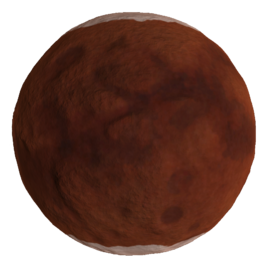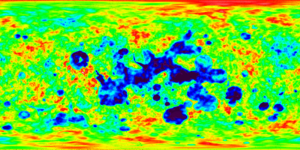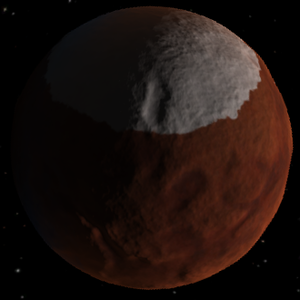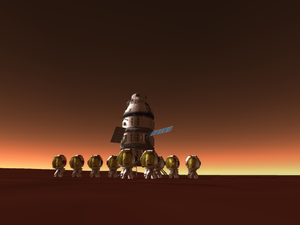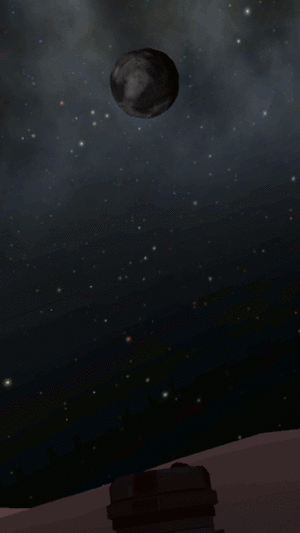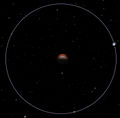Duna/ja
| ドゥナ
(Duna) | ||
| 軌道からみたドゥナ | ||
| 惑星 周回 カーボル | ||
| 軌道の特徴 | ||
| 軌道長半径 | 20 726 155 264 m [Note 1] | |
| 軌道遠点 | 21 783 189 163 m [Note 1] | |
| 軌道近点 | 19 669 121 365 m [Note 1] | |
| 軌道離心率 | 0.051 | |
| 軌道傾斜角 | 0.06 ° | |
| 近点引数 | 0 ° | |
| 昇交点黄経 | 135.5 ° | |
| 平均近点角 | 3.14 rad (で 0秒 UT) | |
| 軌道周期 | 17 315 400 秒 | |
| 801 d 3 h 50 m 0.1 s | ||
| 会合周期 | 19 645 697.3 秒 | |
| 軌道速度 | 7 147 - 7 915 m/秒 | |
| 体格的特徴 | ||
| 赤道半径 | 320 000 m | |
| 赤道周長 | 2 010 619 m | |
| 表面積 | 1.2867964×1012 m2 | |
| 質量 | 4.5154270×1021 kg | |
| 標準重力パラメータ | 3.0136321×1011 m3/秒2 | |
| 密度 | 32 897.302 kg/m3 | |
| 表面重力 | 2.94 m/秒2 (0.3 g) | |
| 宇宙速度 | 1 372.41 m/秒 | |
| 恒星回転周期 | 65 517.859 秒 | |
| 3 d 0 h 11 m 57.9 s | ||
| 太陽の日 | 65 766.707 秒 | |
| 3 d 0 h 16 m 6.7 s | ||
| 恒星回転速度 | 30.688 m/秒 | |
| 同期軌道 | 2 880.00 km | |
| 作用圏 | 47 921 949 m [Note 1] | |
| 大気の特性 | ||
| 大気の有無 | はい | |
| 大気圧 | 6.75500 kPa | |
| 0.066667 atm | ||
| 大気圏高度 | 50 000 m | |
| 6.7×10-8 atm | ||
| 気温最低 | -123.15 °C 150 K | |
| 気温最高 | -40.15 °C 233 K | |
| 酸素存在 | いいえ | |
| サイエンスポイント倍率 | ||
| 着陸 | 8 | |
| 着水 | N/A | |
| 低空 | 5 | |
| 大気圏上層部 | 5 | |
| 低高度宇宙 | 7 | |
| 高高度宇宙 | 5 | |
| 回収 | 5 | |
|
| ||
DunaはKerbol系第四の惑星で、Kerbal Space Programにおける火星のようなものです。赤い惑星で極地には氷があり、衛星Ikeを抱えています。 Ike's size and proximity tidally locks it and Duna to each other.
適切なエアロブレーキを用いれば、KerbinからDuna周回軌道までへの往復飛行に必要なdelta-vはおよそ1700 m/sで済み、他のどの惑星よりも少ない。Dunaはその軌道傾斜の少なさから、多くの場合において最も接近しやすい惑星である。
tutorialにてDunaへの往き方帰り方を解説している。
Contents
ゲーム内での説明
| 「 | 一生懸命目を細めれば見える赤い点としては知られているが、Dunaは長い間Kerbal類にとって不思議な存在だった。 緑とは全くもって正反対の鮮やかな赤色のあの星は畏怖の対象としてずっと扱われて来た。 — Kerbal天文学会 |
」 |
地勢
Duna's terrain ranges in altitude from 124 to 8264 meters. Its mountainous ranges are a peril to landing craft, especially considering the thin atmosphere, which permits very little safe aerobraking and causes Duna's expansive, icy poles.
Duna has several craters, but they appear quite eroded, presumably from wind.
Several maria (large regions of dark soil) are at exactly 0 meters altitude (deprecated). Their flatness and low altitude allow for more aerobraking and make them easy but boring landing locations. These may have been lakes when the planet may have had liquid on its surface in the past.
Duna's surface contains anomalous features.
Atmosphere
Duna's atmosphere begins at 41,446 m. It is only 20% as dense as Kerbin's at sea level altitude and is even less dense relative to Kerbin at higher altitudes. At Duna's highest peak, atmospheric density is only 21% of that at sea level. For comparison, on Kerbin, the atmosphere at the highest peaks is 45% as thick as at sea level. This low density will cause parachutes to semi-deploy much lower, just over 10 km for the Mk25 Parachute, and just under 9 km for all the other parachutes.
In comparison is the atmosphere the thinnest of all bodies with an atmosphere. Even Jool's moon Laythe has a more dense and higher atmosphere. The atmosphere appears to have a reddish or brownish tone itself. On the poles the illuminated atmosphere is coloured although the surface is white.
Landing
Aerobraking can save fuel by reducing orbital and surface velocity greatly. An aerobraking maneuver should maximize time spent in the atmosphere by entering at a shallow angle and aiming for a landing location in a low-lying area. One estimate for a good aerobraking height is 13,000 meters, which will then allow a relatively low delta-V burn at the apoapsis to create a stable orbit safely within Ike's reign of chaos.
Like all atmospheres in the game, Duna's atmosphere fades exponentially with increasing altitude (with a scale height of 3000 m). In general, the atmospheric pressure on Duna at an altitude expressed in meters is:[1]
Although parachutes will deploy on Duna, the atmosphere is so thin that they are usually unable to slow a craft to a safe landing velocity and must be assisted with engines.
Flying
Below 5 km Duna's atmosphere is thick enough to allow wings to generate enough lift for aerodynamic flight. Jet engines don't work for want of oxygen, but other propulsion methods work well. Performing a horizontal landing with a plane is also possible.
Lifting off
An ascent to Low Duna Orbit from the surface typically requires around 1500 to 2000 m/s in Delta-V to reach a 42 km altitude traveling at roughly 950 m/s.
The following table gives terminal velocities at different Duna altitudes, which also the velocities at which a ship should travel for a fuel-optimal ascent from Duna, given the game's model of atmospheric drag.[2]
| Altitude (m) | Velocity (m/s) |
|---|---|
| 0 | 212 |
| 1000 | 231 |
| 2000 | 252 |
| 3000 | 274 |
| 5000 | 324 |
| 8000 | 418 |
| 10000 | 495 |
| 13000 | 638 |
| 15000 | 756 |
| 20000 | 1.16×103 |
Orbital Statistics
The synchronous orbit of Duna is at an altitude of 2 880.00 km above Duna. The speed of the satellite is 306.88 m/秒 and it has an orbital period resonating with 1 Duna day (18.2 hours or 65517.859375 seconds). However, this is the same altitude at which Ike orbits, so unless a ship's orbit is perfectly precise, it will eventually be captured by Ike.
For a semi-synchronous orbit of ½ Duna day (9.1 hours or 32758.9295 seconds) an orbit of 1 695.87 km above Duna is needed with a velocity of 386.65 m/秒.
Observation of Ike
Ike's orbit keeps it directly above a short range of Dunar longitudes. The average Duna longitude that Ike tends to stay directly above (at the Zenith) is 6 degrees east, but the eccentricity of Ike's orbit causes the exact longitude to oscillate between about 2 degrees and 10 degrees east and makes Ike appear to grow slightly larger and smaller to an observer on the surface of Duna. The latitude at which Ike is in the Zenith also oscillates between 0.2 degrees south and 0.2 degrees north due to Ike's orbital inclination, making Ike appear to rotate upwards and downwards as viewed from the surface, but due to the extremely small orbital inclination, this effect is nearly imperceptible. These phenomena together are known as libration. The oscillation in Ike's position above the horizon allows areas from 88°W to 80°W and 92°E to 100°E on Duna to observe Ike rise and set at least partially across the horizon, as can any areas north of 89.8°N or south of 89.8°S.
Interplanetary Travel
From altitude orbit around Duna, the delta-V needed to reach the orbits of other celestials is:
| Body | Delta-V | |
|---|---|---|
| Ike | ~300 m/s | |
| Kerbin | ~620 m/s | |
| Dres | ~820 m/s | |
| Eve | ~1080 m/s | |
| Jool | ~1350 m/s | |
| Eeloo | ~1580 m/s | |
| Moho | ~2100 m/s | |
Reference Frames
| 時間加速中 | 最低高度 |
|---|---|
| 1× | どこでも |
| 5× | 50 000 m (大気圏以上) |
| 10× | 50 000 m (大気圏以上) |
| 50× | 60 000 m |
| 100× | 100 000 m |
| 1 000× | 300 000 m |
| 10 000× | 600 000 m |
| 100 000× | 800 000 m |
Gallery
Duna at sunrise
Changes
- Art Pass
- Minor art pass
- Initial Release
Trivia
- Duna's name may be either a reference to its desert landscape or a reference to the Frank Herbert novel Dune.
- The low-lying areas near Duna's equator make a shape resembling Europe.
- On the surface of Duna, there is a large monument carved in the likeness of a Kerbal face, alluding to the infamous "Face of Mars" discovered in the Cydonia Mensae region of Mars during the 1970's.
- Buried deep under the surface, there is a small camera, similar to the design on the Curiosity rover.
- One anomalous feature on Duna is a small, pyramid-like hill emitting an SSTV signal. When decrypted, it shows a diagram-like image of three figures standing next to the hill itself, implying that Duna was once inhabited or visited before.
Notes
- ↑ A LV-N Atomic Rocket Motor has a specific impulse of 220 in 1 atm, 800 in vacuum, and the following at various Duna altitudes:
altitude (m) 2 100 300 500 1460 2420 3000 4272 5000 10000 specific impulse 684.1 687.8 695.1 701.8 728.7 748.2 757.3 772.1 778.1 795.9 - ↑ http://forum.kerbalspaceprogram.com/showthread.php/6664-Mini-challenge-max-altitude-with-this-supplied-spacecraft?p=100912&viewfull=1#post100912
